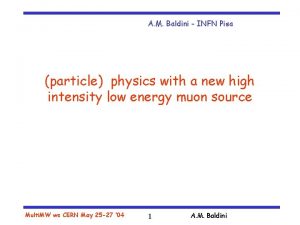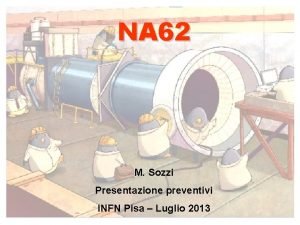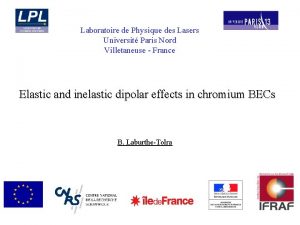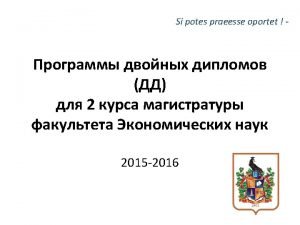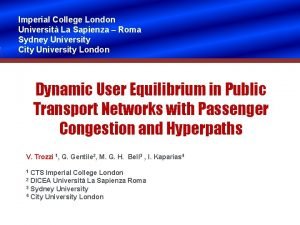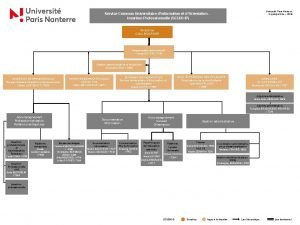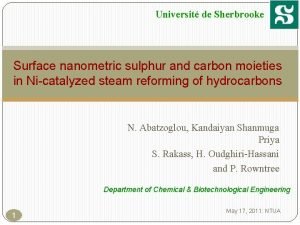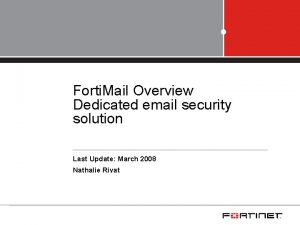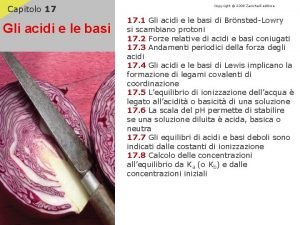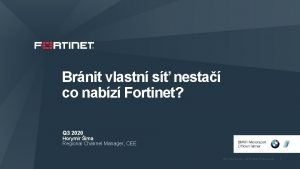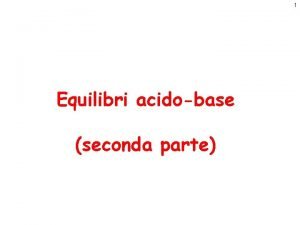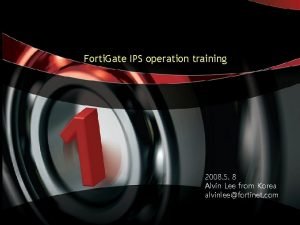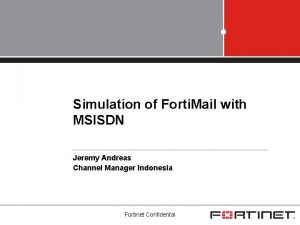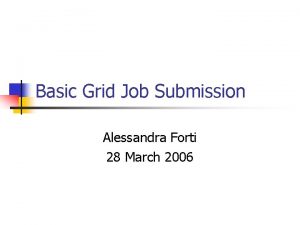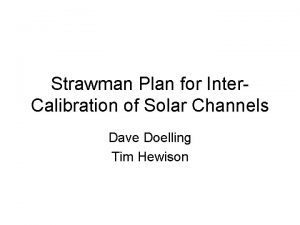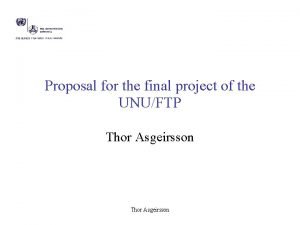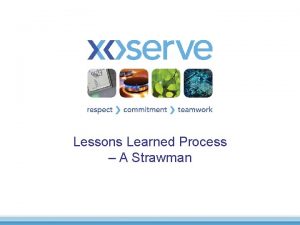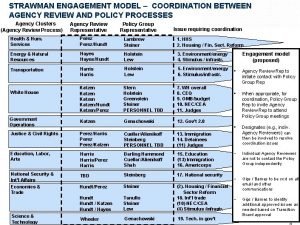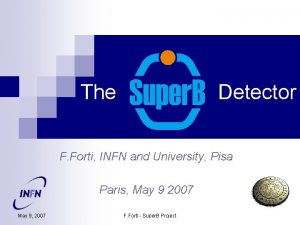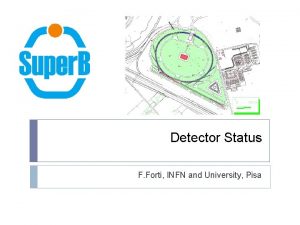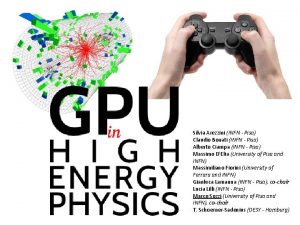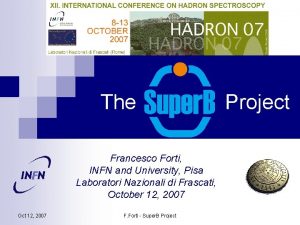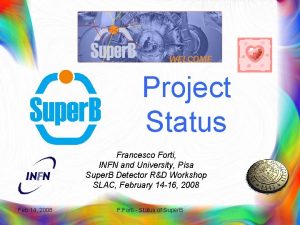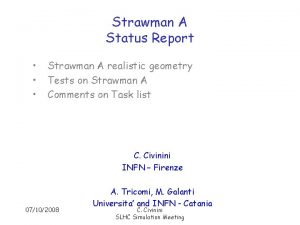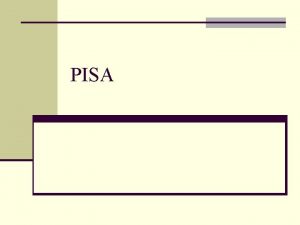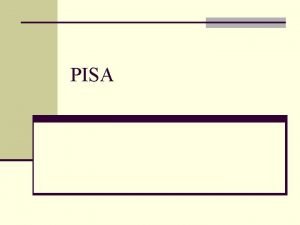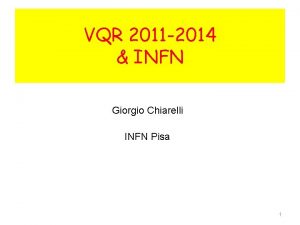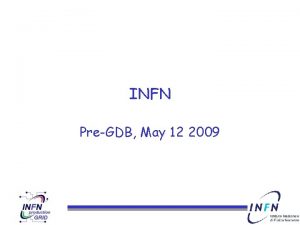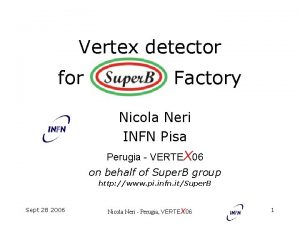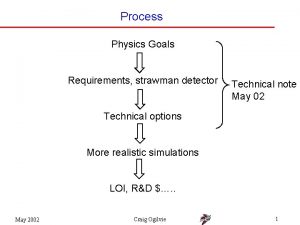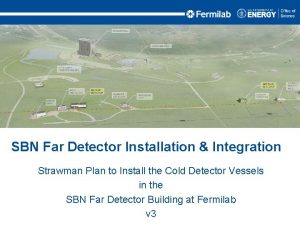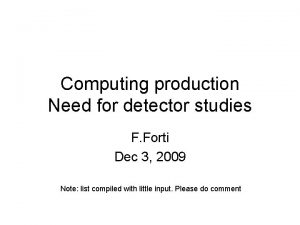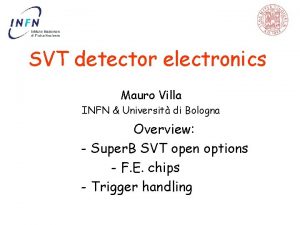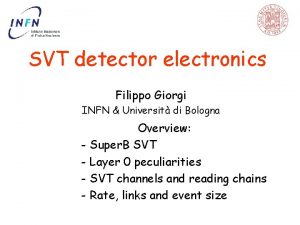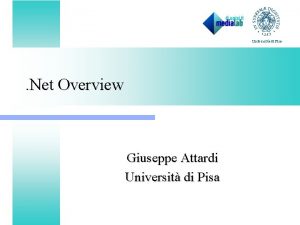Strawman Detector F Forti Universit and INFN Pisa

































- Slides: 33

Strawman Detector F. Forti, Università and INFN, Pisa UK Super. B Meeting Daresbury, April 26, 2006 April 27, 2006 F. Forti - Super. B Strawman Detector

Experimental issues • Babar and Belle designs have proven to be very effective for B-Factory physics – Follow the same ideas for Super. B detector – Try to reuse same components as much as possible • Main issues – Machine backgrounds – Beam energy asymmetry – Strong interaction with machine design • Impact on – Detector segmentation – Radius of beam pipe and first sensitive layer – Radiation hardness April 27, 2006 F. Forti - Super. B Strawman Detector 2

The BABAR Detector 1. 5 T solenoid EMC 6580 Cs. I(Tl) crystals e+ (3. 1 Ge. V) DIRC (PID) 144 quartz bars 11000 PMs e- (9 Ge. V) Drift Chamber 40 stereo layers Instrumented Flux Return iron / RPCs&LSTs ( / neutral hadrons) Silicon Vertex Tracker 5 layers, double sided strips SVT: 97% efficiency, 15 m z hit resolution (inner layers, perp. tracks) SVT+DCH: (p. T)/p. T = 0. 13 % p. T + 0. 45 %, (z 0) = 65 m @ 1 Ge. V/c DIRC: K- separation 4. 2 @ 3. 0 Ge. V/c 3. 0 @ 4. 0 Ge. V/c EMC: E/E = 2. 3 % E-1/4 1. 9 % April 27, 2006 F. Forti - Super. B Strawman Detector 3

April 27, 2006 F. Forti - Super. B Strawman Detector 4

Machine backgrounds • In “traditional” Super BFactory designs – Luminosity obtained with large beam currents (among other things) • 4. 1/9. 4 A for Super. KEKB @ 4 x 1035 • 6. 8/15. 5 A for Super. PEP-II @ 7 x 1035 – Background a significant problem • In December Linear Super. B design – Small fraction of store beam extracted from damping ring at each collision. – Very low current at the IP make backgrounds negligible – Low collision frequency implies event pileup • In March Super. B design – Beam currents are moderate: 1. 5 A @ 1036 – Background important, but should not be a huge problem (smaller than in current BFactories) – Collision at every turn: no pileup, and continuous timestructure as in current BFactories. April 27, 2006 F. Forti - Super. B Strawman Detector 5

Types and level of backgrounds • Extrapolations from current machines – Full simulation is needed to completely understand backgrounds • Beam gas • Synchroton radiation • Both proportional to current – Should not be a problem at Super. B • They become a problem at higher currents • Luminosity sources (eg radiative Bhabhas) – Need careful IR design. – Angle crossing helps (see PEP-II/KEKPB comparison) April 27, 2006 F. Forti - Super. B Strawman Detector 6

BABAR Interaction Region Detector April 27, 2006 F. Forti - Super. B Strawman Detector 7

Radiative Bhabhas April 27, 2006 F. Forti - Super. B Strawman Detector 8

More sources of background • Beam-beam interactions – Potentially important, but probably under control in the low disruption regime. • Touschek background – Intra beam scattering. Goes like 1/E 2. Improves with smaller asymmetry. Increases with beam density. Need further study • Thermal outgassing – Due to HOM losses. Not an issue with small currents • Injection background – Needs further study with the 1 collision/turn scheme. • Bursts – Due to dust. No real cure. Need robustness of detector April 27, 2006 F. Forti - Super. B Strawman Detector 9

Background bottom line • Probably reasonable to assume machine background is not larger than what with have today at Babar and Belle. • Need to design a robust detector with enough segmentation and radiation hardness to withstand surprises (x 5 safety margin) – Seems within reach of current technology – There are critical points, though: • Inner detector radius likely to be reduced more background • Bhabha scattering at small angle can become an issue because of smaller boost more occupancy, more radiation damage • IR design is critical – Radiative Bhabhas – Syncrotron radiation shielding – Shielding from beam-beam blow up April 27, 2006 F. Forti - Super. B Strawman Detector 10

Beam Energy Asymmetry • Machine design prefers lower boost – – Damping rings more similar Babar: 9 + 3. 1 βγ=0. 56 Belle: 8 + 3. 5 βγ=0. 45 Super. B? : 7 + 4 βγ=0. 28 • Most obvious effect on detector – Larger solid angle coverage – Smaller decay vertices separation • We can afford to have a lower boost only if the vertexing resolution is good: – – small radius beam pipe very little material in b. p. and first layer Studies indicate a b. p. of 1 cm would be OK Need a realistic beam pipe design to confirm the viability of the lower boost. – How much cooling is needed in the beampipe ? • Symmetric running is also being studied – Could reduce boost-induced energy smearing in t mg analysis April 27, 2006 F. Forti - Super. B Strawman Detector 11

Beam Pipe Radius • Small beam pipe radius possible because of small beam size – Studied impact of boost on vertex separation (B pp) – Beampipe hypothesis (no cooling) • • 5 um Au shield to protect from soft photons 0. 5 cm 200 um Be and 5 um hit resolution (0. 21% X 0) 0. 5 cm 300 um Be and 10 um hit resolution (0. 24% X 0) 0. 5 cm 500 um Be and 10 um hit resolution (0. 29% X 0) – Rest of tracking is Babar Separation significance April 27, 2006 Proper time difference resolution F. Forti - Super. B Strawman Detector 12

Beam Pipe Thickness • With 1. 5 A beam currents the beam pipe will require cooling. – Beampipe design is being developed – Study effect of beampipe thickness • • Assume boost=0. 28 B pp decay 10 um hit resolution 1 cm beampipe should allow good performance even with bg=0. 28 April 27, 2006 Ba. Bar F. Forti - Super. B Strawman Detector Proper time difference resolution 13

Energy • Is it interesting to run at different energies ? – Υ(5 s): not an issue for the machine – oscillation of Bs rapid for TD analysis • Required resolution very hard to obtain • Still it might be possible to measure g through timeintegrated measurement branching fractions • Bs Df • Bs K+p+p 0 Renga/Pierini April 27, 2006 F. Forti - Super. B Strawman Detector 14

Energy II • Is it interesting to run at the tt threshold or at the y(3770) ? – Luminosity will be around 1035 – Still more than at tau-charm factories – Studies going to on on physics case • • Absolute D branching fractions, rare decays Form factors Unitarity tests with charm D mixing ? Use coherence of initial state • CP violation <Dz>/s(Dz) vs bg • Boosted operation – Is there something to be gained to run at low energy with boost ? – It might be possible to separate (a little bit) the D vertices April 27, 2006 F. Forti - Super. B Strawman Detector 15

Silicon Vertex Tracker • Vertexing – Two monolithic active pixel layers glued on beam pipe • Since active region is only ~10 um, silicon can be thinned down to ~50 um. x 5 scale with 10 mm radius • Good resolution O(5 um). BP, 6 mm pixel chip • Good aspect ratio for small radius (compared to strips) • Improves pattern recognition robustness and safety against background • needs R&D: feasability of MAPS, overlaps, cables, cooling • Quite a bit of R&D going on on MAPS April 27, 2006 F. Forti - Super. B Strawman Detector 16

MAPS R&D CAP chip (Belle collaborators) CAP 1: simple 3 -transistor cell TSMC 0. 35 mm Process Vdd Source follower buffering of collected charge Reset M 1 M 2 Restores potential to collection electrode Collection Electrode M 3 Row Bus Output Gnd Column Ctrl Logic Pixel size: 22. 5 mm x 22. 5 mm 1. 8 mm Column Select 132 col*48 row ~6 Kpixels CAPs sample tested: all detectors (>15) function. TESTED IN BEAM. April 27, 2006 F. Forti - Super. B Strawman Detector 17

MAPS R&D II • SLIM chip (Babar collabor. ) Charge sharing threshold 55 Fe ST 0. 13 um triple well technology Single pixels tested with source Full signal processing chain PRE SHAPER DISC X-rays Noise only (no source) LATCH threshold April 27, 2006 =105 m. V =12 m. V F. Forti - Super. B Strawman Detector Landau peak 80 m. V 12501640 90 Sr electrons saturation due to low energy particle. 2200 3000 (e-) 18

Silicon Vertex Tracker • Intermediate silicon tracking – More or less like the current Si strip detectors: • 5 layers of 300 um Si, strip lengths 5 -20 cm, pitch 50 -200 um, shaping time 100 -400 ns – Reduction in thickness would be desirable, but not essential • Possibility of 200 um Si in inner layers – Small angle region will require special attention due to the high Bhabha rate 20 cm 30 cm April 27, 2006 40 cm F. Forti - Super. B Strawman Detector 19

Central Tracker Normal cell(17. 3 mm) • Babar and Belle Drift Chambers – – Both use He based gas mixture Cell size 12 -18 mm Maximum drift time ~500 ns Resolution in the best part of the cell ~100µm – Expect that either OK. • Solid state tracking – an all-silicon solution evaluated, but not performant at low momentum, expensive, and not really needed with moderate backgrounds Small cell(5. 4 mm) • Need to optimize cell size against occupancy – Belle has developed a fast gas small cell DCH, but with a degraded resolutions (5. 4 mm, ~150µm) • Solutions exists, although a full design is needed April 27, 2006 F. Forti - Super. B Strawman Detector 20

Particle Identification • Current solutions for K identification – Low p: • d. E/dx (both Babar and Belle) • TOF (Belle only) – High p: dedicated Cherenkov detector • DIRC (Babar) – ring imaging cherenkov counter • ACC(Belle) – aerogel threshold cherenkov counter – Coverage: • only barrel(Babar) • barrel+endcap (Belle) • Evolution – Ring imaging is superior to threshold counters • Need to resolve background and mechanical issues – Forward and backward endcap coverage very desirable to increase effective luminosity • A different kind of problem • R&D is needed April 27, 2006 F. Forti - Super. B Strawman Detector 21

Babar PID • Stand-off box, filled with water expands cone on PM – Source of backgrund • Barrel-only device • Mechanical interference in the backward direction April 27, 2006 F. Forti - Super. B Strawman Detector 22

Belle PID • Aerogel Cherenkov Counters, Time of Flight – No high mom. PID for endcap – Material (ACC+TOF ~ 0. 35 X 0) April 27, 2006 F. Forti - Super. B Strawman Detector 23

Evolution: Babar-Style Fast DIRC • Replace SOB with compact readout • Tested in beam with – Hamamatsu Multi Anode Photo Multipliers – Burle Micro Channel Plate PMTs April 27, 2006 F. Forti - Super. B Strawman Detector 24

DIRC with timing: TOP Simulation 2 Ge. V/c, q=90 deg. • Cherenkov ring imaging with precise time measurement – Quartz radiator (2 cm-thick) • Basic study was already done. – Photon detector (MCP-PMT) • Good time resolution < ~40 ps • Single photon sensitive under 1. 5 T – Test with Ga. As. P photo-catode + MCPPMT very promising -K separation power April 27, 2006 F. Forti - Super. B Strawman Detector K d-ray, had. int. 25

Focusing Aerogel-RICH • New imaging technique by introducing multiple radiators n 1<n 2 n 1>n 2 n 1 n 2 Focusing type n 1 n 2 n 3 n 4 n 1<n 2<n 3<n 4 Defocusing type n 1 n 2 n 3 n 4 n 2<n 1<n 4<n 3 Increase Cherenkov photons without loosingle angle resolution due to emission point uncertainty April 27, 2006 Take full advantage of controllable index of aerogel F. Forti - Super. B Strawman Detector 26

Electromagnetic calorimeter • Both Babar and Belle use Cs. I(Tl) calorimeters are suitable for Super. B – signal decay time of ~. 75µs (dominant) and ~3µs are OK • Cs. I(Tl) is too slow for endcap – need to deal with Bhabha rate spatial and temporal overlaps. – especially if possible to extend coverage to 100 mrad, beam line elements allowing. • Babar forward is 350 mrad, Belle forward 200 mrad, backward 400 mrad • Encap replacement is needed – In the case of Babar, a backward endcap needs to be added altogether • Solutions seem to be viable with some R&D April 27, 2006 F. Forti - Super. B Strawman Detector 27

Candidate materials • Pure Cs. I – Fast (16 ns) – Low light yield (2500 g/Me. V) • LSO or LYSO – High light yield (27000 g/Me. V) – Speed OK (47 ns) – Expensive April 27, 2006 F. Forti - Super. B Strawman Detector 28

Other Detector components • Muon and KL detector – Inside the return yoke of magnet – It doesn’t seem to be a problem – avalanche mode RPC, LST, scintillator are all viable • Trigger/DAQ – Not substantially different from current schemes. – Keep open trigger scheme – Need to try vetoing Bhabhas at level 1 – Data rate seems well manageable April 27, 2006 F. Forti - Super. B Strawman Detector 29

Reusability of Babar and Belle • Large (expensive) portions of Babar or Belle would be reusable – Barrel calorimeter – Magnet – Barrel LSTs for Babar • But large subsystems need to be replaced or significantly upgraded – – Tracking and vertexing Particle ID Endcap calorimeter Trigger/DAQ • Babar or Belle seem good foundations for a Super. B detector – But need to look in detail at integration and mechanical structure issues April 27, 2006 F. Forti - Super. B Strawman Detector 30

From Hitlin’s talk at March 06 LNF April 27, 2006 F. Forti - Super. B Strawman Detector 31

From Hitlin’s talk at March 06 LNF April 27, 2006 F. Forti - Super. B Strawman Detector 32

Outlook • A detector for Super. B seems to be feasible • An R&D plan needs to be formulated to address the remaining issues – Vertexing – Particle ID – Calorimetry • Babar and Belle provide excellent foundations for a detector at Super. B • More detailed studies will be possible once the machine parameters have settled. April 27, 2006 F. Forti - Super. B Strawman Detector 33
 Infn pisa
Infn pisa Infn pisa
Infn pisa Universit
Universit Rotterdam school of economics
Rotterdam school of economics Universit of london
Universit of london Organigramme nanterre
Organigramme nanterre Universit sherbrooke
Universit sherbrooke Acidi e basi forti e deboli
Acidi e basi forti e deboli Sender reputation fortimail
Sender reputation fortimail Forti auth
Forti auth Acidi e basi forti e deboli
Acidi e basi forti e deboli Forti deceptor
Forti deceptor Soluzione neutra
Soluzione neutra Acidi e basi forti e deboli
Acidi e basi forti e deboli Forti ips
Forti ips Coppia di vocali da pronunciare separatamente
Coppia di vocali da pronunciare separatamente Forti et fideli nihil difficile
Forti et fideli nihil difficile Forti tester
Forti tester Fortimail matrix
Fortimail matrix Forti nac
Forti nac Pronomi personali forma forte
Pronomi personali forma forte Chimica analitica
Chimica analitica Bisogna essere molto forti per amare la solitudine
Bisogna essere molto forti per amare la solitudine Alessandra forti
Alessandra forti Alessandra forti
Alessandra forti Straw man proposal template
Straw man proposal template Strawman plan
Strawman plan Strawman plan example
Strawman plan example Strawman proposal template
Strawman proposal template Strawman proposal template
Strawman proposal template Final project proposal
Final project proposal Lessons learned purpose
Lessons learned purpose Strawman model
Strawman model Access process data
Access process data
